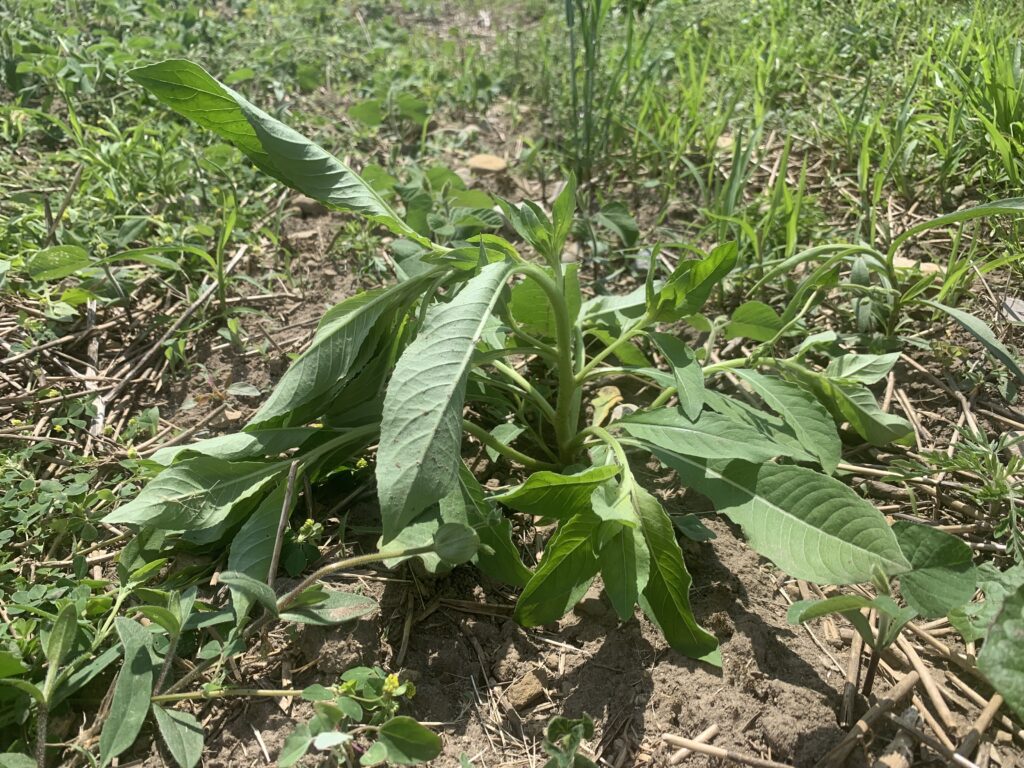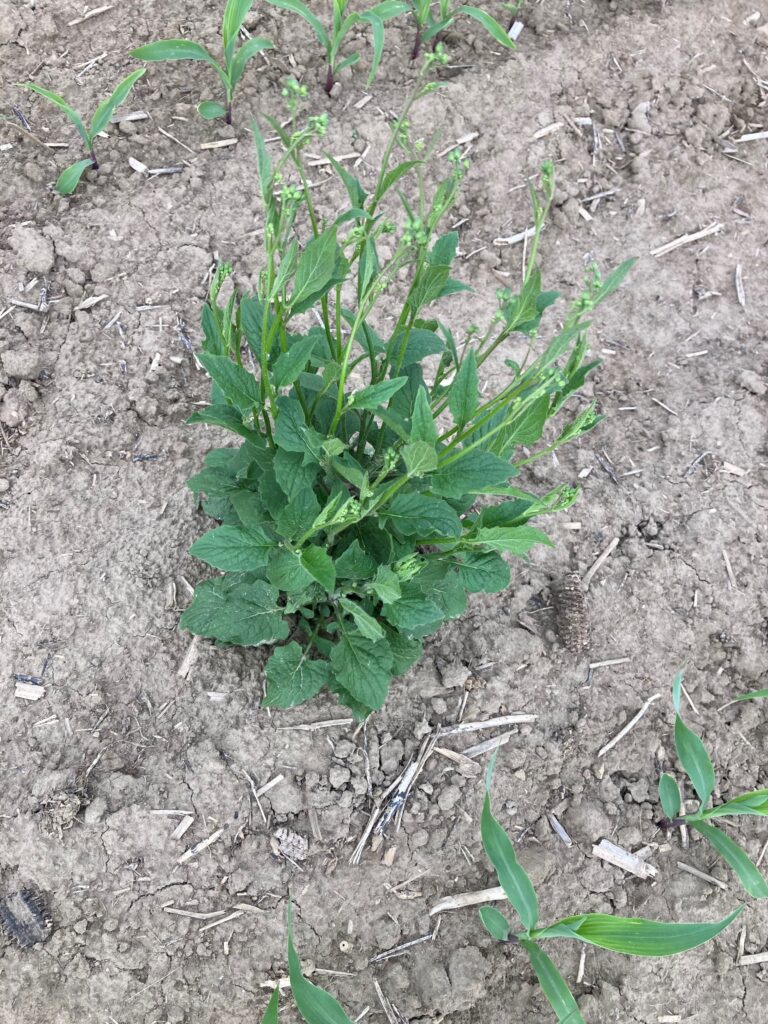The morning of the meeting, rain was still falling and had been since the previous evening. Reported rainfall amounts at the time ranged from 0.5- 1.25 inches, with some in southern counties (Lambton, Middlesex, Bruce and Grey counties) reporting over 2 inches.
Cereals
Herbicide applications are underway in spring cereals and reports indicate these crops are looking good across the province, including the northeast. Seeding deadlines were extended until June 5th in Northwestern Ontario to support producers dealing with record-breaking rainfall. However, continued wet conditions meant that most seeding of cereals had not been completed by June 5th.
Cereal leaf beetle is not being observed in high numbers yet this season, even in areas where pressure has been high in recent years. Little to no disease has been reported to date in winter wheat, aside from some cases of powdery mildew that has been linked to susceptible varieties. Fungicide applications for prevention of fusarium head blight are either complete or planned for this week when the weather cooperates. Some producers have reported that they do not observe pollen on the heads, making it difficult to determine the ideal fungicide application stage. Wheat anthers may not extrude pollen but if heads are fully exposed the window for fungicide application is open, provided it has not entered the preharvest interval – check the fungicide label for the preharvest interval. Wheat planted in November is heading now.
Soybeans
The spring has been relatively normal in terms of soybean seeding and progress. While unplanted fields have been noted in some areas, soybean growth stages range from emerging to 2nd trifoliate stage. Populations look low in some fields and this may be because of poorer performance of drills on heavier soils compared to row unit planters. Some no-till fields look thin and a few replants have occurred. Soybeans can perform well with thinner stands, and it is commonly reported that no-till soybeans look tough early in the season but yield similar to tilled fields. Cool nighttime temperatures and crusted soils may contribute to slow or reduced emergence. Rolling before rain can increase risk of crusting. Rolling at V1 (first trifoliate) during the heat of the day with a smooth roller is recommended and does not significantly damage plants or reduce stands compared to other timings.
Some wireworm and seedcorn maggot have been observed but overall reports of these pests are low. Bean leaf beetle have been noted in early emerging soybean fields, and typically these fields are second year soybeans or adjacent to alfalfa fields. During soybean seedling stages (VC-V2) the threshold is 16 adult beetles per 30 cm of row, although control is also warranted if they are clipping stems. Black cutworm has also been reported in some soybean fields which is uncommon, and there is no specific threshold established. Monitor the level of stem clipping and plant populations and consider controlling cutworm where stands are being affected, the larva are still small (under 2.5 cm) and seed for replanting is not available. Bt traits should control cutworm, but ingestion of the toxin requires they feed on a plant and therefore clip off a stem. Within two weeks they should no longer be an issue.
Soil applied herbicide injury on soybeans has been observed. This has primarily been with group 14 products (e.g. Authority, Valtera). These herbicides are an important part of a successful weed management program but injury can be observed after rainfall or on certain soil types. The worst damage is often seen when there is rainfall right as beans are knuckling through the soil surface (Figure 1). This can result in browning of the cotyledons and hypocotyl, and the first leaves may also show injury but does not typically result in stand reductions. Ilevo injury has also been observed on soybean cotyledons. The seed leaves will have a yellow halo which may turn necrotic but this does not result in stand reductions. Ilevo seed treatment is becoming more common in areas where there is high SCN (soybean cyst nematode) and SDS (sudden death syndrome) pressure.

Corn
Corn growth progress looks good and stands are generally healthy. Some producers have noted purpling of leaves on corn seedlings. In many cases this is related to genetics and is not a major concern. Where it is related to genetics, purpling may be present on the first 4 to 5 leaves and occurs after a few bright, sunny days followed by cool nights. It is a result of anthocyanin pigment formation. With warm weather the corn will outgrow this quickly, but the purpling may remain if growth is slow due to cool temperatures. If purpling is uneven across the field and continues beyond the 6 leaf stage, there may be a phosphorous deficiency. Deficiency will be most visible on the oldest leaves and may result in stunted growth. Soil tests will aid in diagnosing phosphorous deficiency.
There was discussion about soil nitrate levels being very high in fields where hog manure had been applied. Warmer soils in May may have accelerated organic N mineralization, so where there was red clover or manure before corn there may be N available when corn demands its.
Participants are requested for the Corn Rootworm Trap Network. GFO has provided funding to make sticky traps available, and trap sites and data are entered online. Contact Tracey Baute (tracey.baute@ontario.ca) if you want to monitor some sites. More details HERE.
Dry Beans
Dry bean planting is ongoing, and soil conditions have been good. Adzuki beans, which are often planted earlier than other market classes, have emerged in many fields. Some white and black beans have emerged but the majority of bean fields were planted within the past week. Cranberry beans are typically planted last because they mature faster than other beans. Early June is the ideal planting window, when soil conditions and temperatures allow, but planting will continue to mid-month. Later plantings often result in issues with late harvest. It is expected that acreage of dry bean in Ontario will be lower this year than in the past 5 years.
Canola
Flowering is ending in winter canola. Numerous fields were terminated after late fall planting, too much fall rainfall, and a tough winter and spring. Some fields that were kept have thin stands or had minimal foliage and may not have very high yields, but yield predictions are difficult and canola can compensate for thin stands. Harvest timing may be similar to last year – mid-July – depending on region, how early flowering began, and weather at harvest.
Spring canola in the region is reported to be in good condition and at the 3 to 6 leave stage. Herbicide is being applied. There have not been reports of flea beetle although this pest is common, and producers are generally very familiar with how to deal with it when issues arise.
Weeds
A summary of uncommon weeds being found in fields was provided. Pineapple weed is an annual weed that may not be controlled by low rates of glyphosate (0.67 L/acre), but high rates typically provide control (1.34 L/acre). Yellow evening primrose (Figure 2 and 3) and nipplewort (Figure 4) in soybeans can be controlled with glyphosate plus dicamba. You can find info about controlling nipplewort in wheat HERE. Jimsonweed (Figure 5) is a nightshade species that is usually uncommon but has been reported in Waterloo, Oxford and Niagara.




Agricorp
Important dates:
June 15, 2022 – Report Unseeded Acres
June 30, 2022 – Report Acreage
July 10, 2022 – Pay Premiums
You can find the Spring Planting Deadline Factsheet HERE.
Ontario Diagnostic Days
OMAFRA and UG will be putting forward a hybrid version of diagnostic days. The live event will be held at Ridgetown Campus on Wednesday and Thursday July 20-21 with limited attendance. The sessions will be taped and offered virtually to the Ontario Ag Community similar to the previous two years. Information and registration for the event is available here.